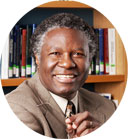 By Dr. Calestous Juma
By Dr. Calestous Juma
Much of the conflict around the world is a result of social inequities that undermine societies’ ability to pursue sustainable development. The focus on expanding human capabilities helps society to look to an open, positive, and prosperous future. This is in contrast with a world in which the future appears closed with little opportunity for growth. Such a worldview is a major source of conflict, and individuals and communities resort to competing for seemingly limited resources instead of deploying their creativity to expand opportunities. Such inequities make it difficult for communities to leverage the world’s scientific and technological knowledge and use it to advance development.
It is widely acknowledged that science and technology has an important role to play in meeting the UN Sustainable Development Goals (SDGs). To appreciate the importance of science and technology we have to focus on the view that implementing the SDGs is a practical matter involving the application of useful knowledge encoded in engineering practices[1].
Such useful knowledge needs to meet two key criteria. It needs to be accessible and be based on inspirational lessons. The field of engineering offers the best possibility for combining these criteria into practical programmes that can show results within a generation.
Much of the engineering knowledge needed to enable countries, regions, and communities to pursue sustainable development already exists. It is widely distributed in enterprises, in research institutes, and among private individuals worldwide. The best way to access this knowledge is by tapping into global knowledge networks.
The case of mobile technology in Africa illustrates this point. Mobile phones were not invented in Africa. But when they became available they provided a basis for the creation of new digital industries and businesses[2] that had not been anticipated by the original inventors.
 The globalisation of telecommunications technologies makes it even easier for poor regions around the world to tap into the world’s fond of engineering knowledge for sustainable development. This covers emerging engineering fields such as synthetic biology, machine learning, drones, and 3D printing.
The globalisation of telecommunications technologies makes it even easier for poor regions around the world to tap into the world’s fond of engineering knowledge for sustainable development. This covers emerging engineering fields such as synthetic biology, machine learning, drones, and 3D printing.
There is ample evidence of countries that overcame poverty by harnessing existing engineering knowledge to promote development. Many of them laid industrial foundations using existing technologies from which they launched into new products and markets. Technological leapfrogging is not just feasible, it is desirable for countries that seek to escape traditional growth patterns and promote green economies.
You May Also Like:
Unfortunately, countries and regions that are bedeviled by extreme inequities are also the ones with limited opportunities for obtaining engineering expertise. There are at least two ways to ramp up engineering competence in these countries.
The first is to make deliberate efforts to promote innovation[3] by adding engineering courses and modules to existing university curricula. This does not necessarily mean building new engineering schools, but it will entail bringing the logic of engineering to existing courses. This includes exploring how to add engineering components to the humanities and social sciences. Similarly, engineering courses need to have a stronger focus on solving social and environmental projects. Such efforts will help to reduce the traditional tensions between the arts and sciences.
A complementary route is to empower the private sector to play a larger role in offering engineering education. Many firms have high-quality in-house training programmes that could serve as new avenues for expanding engineering education for sustainable development. Achieving this goal requires formal recognition by governments that firms are important centres of learning and that some of their in-house training efforts could be supported and enabled to serve the larger public good.
The rise of nations such as South Korea, Singapore and China as global economic players illustrated the importance of expanding and deepening human competence. A key starting point in the growth process is recognising that building engineering capabilities offered the best opportunity for technological leapfrogging and catch-up in a variety of industries. The challenge today is to draw lessons from such inspirational examples and design development strategies with sustainability objectives in mind.
These proposals are only meaningful in environments where governments are committed to pursuing peace and prosperity through inclusive development. In his thoughtful advice to world leaders, Norwegian peace scholar Johan Galtung says the world will not achieve peace through security but will achieve security through peace. The first step in pursuing peace is to enhance human capabilities by expanding engineering education.
(Dr. Calestous Juma FRS HonFREng is Professor of Practice of International Development at Harvard Kennedy School and author of ‘Innovation and Its Enemies’.)
[1] Engineering Change: Towards a sustainable future in the developing world, Peter Guthrie, Calestous Juma and Hayaatun Sillem, 2008
[2] Cashing In on the Digital Revolution, Njuguna Ndung’u, Armando Morales, and Lydia Ndirangu, 2016
[3] Education, Research, and Innovation in Africa: Forging Strategic Linkages for Economic Transformation, Calestous Juma, 2016










